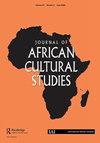黑人美学与深水:南非的鱼人、美人鱼艺术与奴隶记忆
IF 0.9
2区 社会学
Q2 CULTURAL STUDIES
引用次数: 0
摘要
摘要玛米·瓦塔是印度洋和大西洋世界中备受尊崇的水精灵。在南非,一个美人鱼形象的水精灵有很多名字,因为她的其他语言能力而受到恐惧或尊敬。我认为,这个美人鱼的形象是奴隶制记忆的场所,也是黑人和以前被奴役的社区与水之间麻烦关系的提醒。我分析了“水美人”(水上少女/水上女孩)形象的艺术表现,这是一种半人半鱼的美人鱼生物。我讨论了这个人物是如何作为南非女艺术家调查奴隶制前后生活的一个讨论场所发挥作用的。我认为,作为游牧民族的水美人为我们提供了对南部非洲奴隶记忆的推测性重新映射。这篇文章探讨了海洋和美人鱼的形象是如何出现在Koleka Putuma、Claudette Schreuders和Nelsiwe Xaba的作品中的,他们通过绘制奴隶谱系图,利用奴隶制在水中和水中的根源/路线,将南非水域和话语中的复杂性带到了焦点。本文章由计算机程序翻译,如有差异,请以英文原文为准。
Black Aesthetics and Deep Water: Fish-People, Mermaid Art and Slave Memory in South Africa
ABSTRACT Mami Wata is a water spirit venerated across the Indian and Atlantic Ocean worlds. In South Africa, a water spirit who is a mermaid figure goes by many names and is either feared or revered for her other-wordly powers. This mermaid figure, I argue, functions as site of slavery memory as well as a reminder of the troubled relationship black and previously enslaved communities have with water. I analyse artistic representations of the figure of the “watermeisie” (water maiden/water girl), a kind of mermaid creature who is half-human and half-fish. I discuss how this figure functions as a discursive site for South African women artists’ investigations into the before- and afterlives of slavery. I argue that the watermeisie as nomadic figure provides us with a speculative re-mapping of slave memory in Southern Africa. The article examines how the ocean and the figure of the mermaid appear in works by Koleka Putuma, Claudette Schreuders and Nelisiwe Xaba, artists who have brought the watermeisie with all its complexity in South African waters and discourse into focus, by charting a map of slave genealogies using the roots/routes of slavery in and out of water.
求助全文
通过发布文献求助,成功后即可免费获取论文全文。
去求助
来源期刊

Journal of African Cultural Studies
Multiple-
CiteScore
1.70
自引率
10.00%
发文量
13
期刊介绍:
The Journal of African Cultural Studies publishes leading scholarship on African culture from inside and outside Africa, with a special commitment to Africa-based authors and to African languages. Our editorial policy encourages an interdisciplinary approach, involving humanities, including environmental humanities. The journal focuses on dimensions of African culture, performance arts, visual arts, music, cinema, the role of the media, the relationship between culture and power, as well as issues within such fields as popular culture in Africa, sociolinguistic topics of cultural interest, and culture and gender. We welcome in particular articles that show evidence of understanding life on the ground, and that demonstrate local knowledge and linguistic competence. We do not publish articles that offer mostly textual analyses of cultural products like novels and films, nor articles that are mostly historical or those based primarily on secondary (such as digital and library) sources. The journal has evolved from the journal African Languages and Cultures, founded in 1988 in the Department of the Languages and Cultures of Africa at the School of Oriental and African Studies, London. From 2019, it is published in association with the International African Institute, London. Journal of African Cultural Studies publishes original research articles. The journal also publishes an occasional Contemporary Conversations section, in which authors respond to current issues. The section has included reviews, interviews and invited response or position papers. We welcome proposals for future Contemporary Conversations themes.
 求助内容:
求助内容: 应助结果提醒方式:
应助结果提醒方式:


